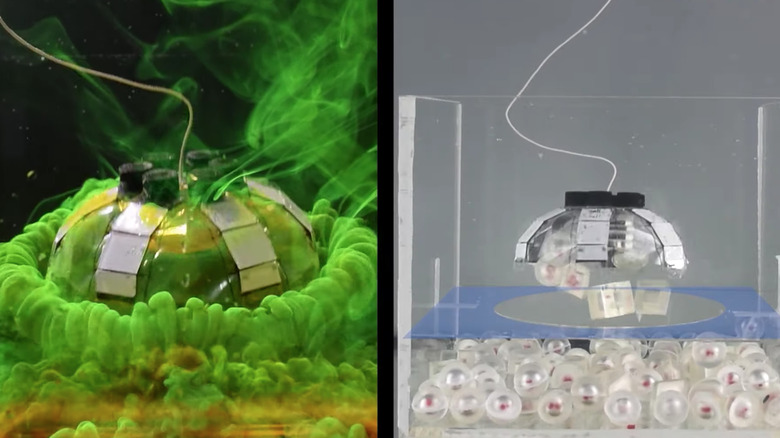Jellyfish-Inspired Robots May One Day Clean Ocean Beds Without Even Touching The Trash
Jellyfish and octopus have frequently served as an inspiration for soft robotics, especially when it comes to designing appendages that can delicately handle fragile objects. Now, the experts over at Max Planck Institute for Intelligent Systems (MPI-IS) have designed a jellyfish-inspired robot that can collect objects from the waterbed without physically touching them. Called "Jellyfish-Bots," the robot only needs 100mW of electricity, which means it doesn't pose any harm to humans or aquatic life, even if the insulating layer around the body wears off.
"Jellyfish-Bot interacts gently with its environment without disturbing it — much like its natural counterpart," says the team behind the unique robot. The robot, which is nearly the size of a hand and almost noise-free, relies on electrohydraulic actuators, which maintain electrical flow and also serve as the muscles that regulate movement. These "muscles" — also known as HASELs — are surrounded by air cushions for stabilization towards underwater movement, and also serve as a layer of protection for the internal circuitry.
The artificial muscles contract and relax through periodic electric currents flowing through the wires, allowing the robot to swim through the water. As the Jellyfish Bot moves, it also circulates the water around, which makes it easier to agitate everything from plastic waste to fragile marine samples above the sea bed, and lift them up to the surface.
Cleaning the ocean, one arm at a time
"70% of marine litter is estimated to sink to the seabed," notes Hyeong-Joon Joo, co-author of the research paper published in Science Advances. The robot can work alone, as well as in groups, moving at a speed of up to 6.1 centimeters per second. The robotic movements are delicate enough that they can also handle fish eggs on the ocean floor.
Four of the robot's arms function as propellers, while the other two act as grippers. Right now, the robots require a wire to operate, but the team has already figured out modules for battery and wireless communication to achieve a truly wireless operational convenience. While tests in a pond setting have been successful, the team is now looking at improvements that could offer more control over steering and mobility, especially in challenging oceanic environments.
The team is also looking at using biodegradable materials for the construction of the robotic parts. Research is also underway to boost the lifespan of these bots. During the tests, the team managed 10 cycles from bed to the surface of a tank, 20 times each day for two weeks, without breaking down the Jellyfish Bot test samples. The team is looking at solutions like self-clearing electrodes, dielectric coatings for stronger heat seals, and using adhesives to avoid electric failures.
